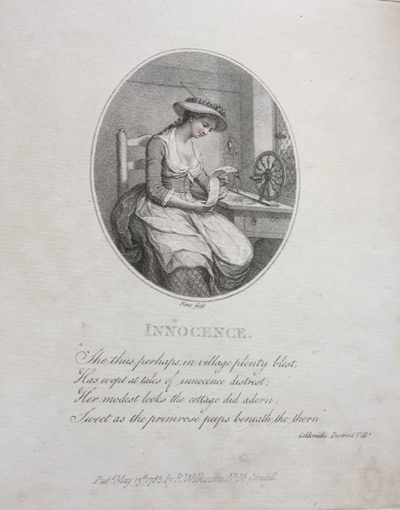Innocence
This is one of a pair of prints, Innocence and Remorse by Gillray illustrating lines from Goldsmith's popular poem The Deserted Village (1770). The prints were published in both black and brown ink versions on May 13th 1783 by Robert Wilkinson with whom Gillray was to collaborate on approximately 30 non-caricature prints from 1779 to 1794. As he often did at the start of his career, Gillray used an alias: in this case simply "Kent fecit.". In other Wilkiinson prints, he would sign "J. Kent fecit."

© Private Collection
Written squarely in the pastoral tradition, The Deserted Village laments the disappearance of the purity and simplicity of rural life as progressive enclosures and growing commercialism were forcing or luring families out of their homes and into the cities. Innnocence illustrates and includes lines 327–330 from the poem where a young country girl, "sweet as a primrose," "once, perhaps, in village plenty bless'd,/ Has wept at tales of innocence distress'd." In Remorse, now "lost to all, her friends, her virtue, fled," she
deplores that luckless hour,
When idly first, ambitious of the town,
She left her wheel, and robes of country brown. (334–336)
Gillray departs from the poem in several significant ways. The girl appears to be reading a letter, not a "tale of innocence distres't." She does not appear to be weeping at the news in the letter. And her dress seems more fashionable than "robes of country brown" mentioned in the poem. In fact, it seems more likely Gillray is foreshadowing her fate, portraying the interest in fashion and seduction that will lead to her downfall. In that case, the spinning wheel may be an allusion to Ariadne, whose tale was popular in both print and painting at the time, who was seduced and then betrayed by Theseus.
The prints were obviously intended to be seen together. The spinning wheel shown in Innocence, for instance, is only mentioned in the lines in Remorse. And like Hogarth's series, A Harlot's Progress, the prints were meant to inculcate a moral. But like the furniture prints of Bartolozzi and Cipriani, they are part of a much more sentimental tradition than Hogarth. Gillray successfully mimicks the stipple engraving style of Bartolozzi from whom he may in fact have received instruction at the Royal Academy Schools.
Sources and Reading
- Oliver Goldsmith, Full text of "The Deserted Village," Bartleby.com
- "The Deserted Village," Wikipedia
- "Francesco Bartolozzi," Wikipedia
Comments & Corrections
NOTE: Comments and/or corrections are always appreciated. To make that easier, I have included a form below that you can use. I promise never to share any of the info provided without your express permission.